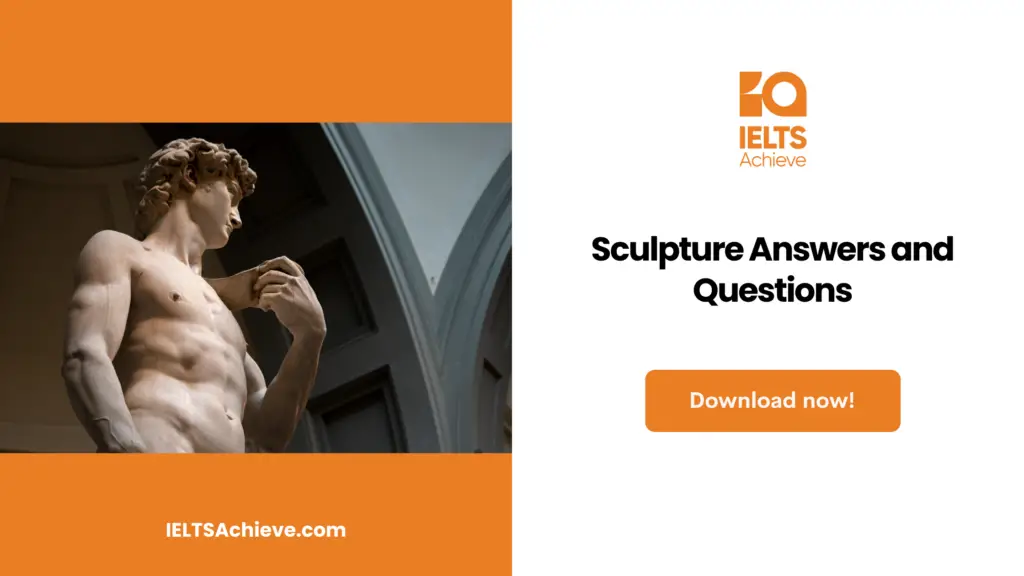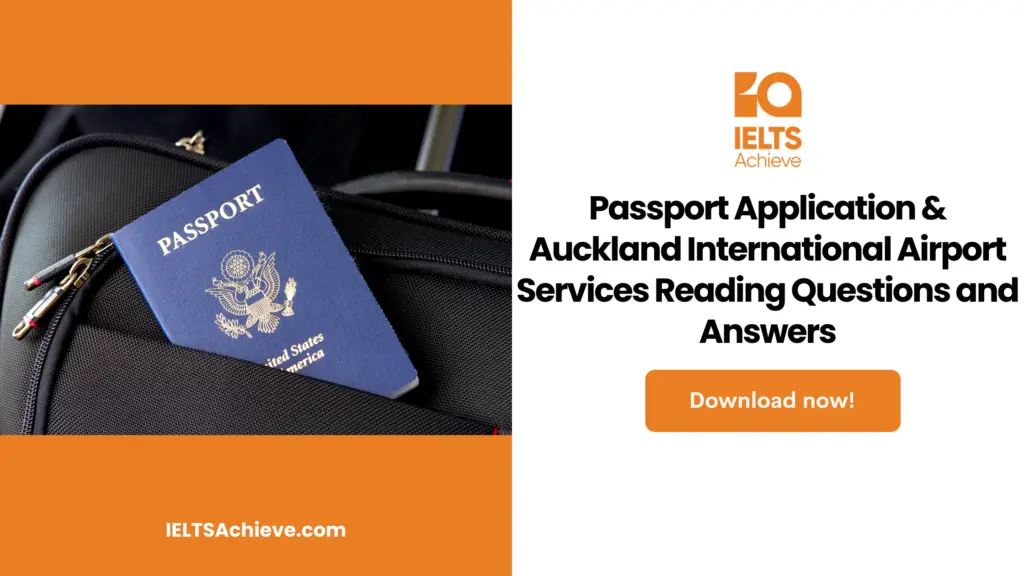The Blog post contains the following IELTS Reading Questions:
- IELTS Reading Table Completion
- IELTS Reading Short Answer Questions
- IELTS Reading Summary Completion
Stay informed and prepared for success – Explore our comprehensive Reading Test Info page to get valuable insights, exam format details, and expert tips for mastering the IELTS Reading section.
IELTS Reading Passage – Sculpture

Sculpture
The creation of a three-dimensional item for the express purpose of art and beauty has been going on since ancient times. Traditional sculptures have been crafted from permanent materials including metal, stone, marble, and jade; however, several subgenres of the art form specialise on making figures of a more transitory nature, such ice sculpture. In many countries, the sculpture has historically been connected with religious thinking; for instance, Numerous renowned sculptures in Asia are associated with Hinduism or Buddhism.
Perhaps more so than elsewhere in the world, Africa favoured and celebrates three-dimensional artwork above two-dimensional artwork. Because of evidence of sculpture’s existence in Pharaonic Africa, some experts place the origin of sculpture in Africa to the time of 500 B.C. Nok Civilization in Nigeria.
In the presence of a trained eye, the distinctive style and medium of African art from various regions become immediately obvious. Two unique types may be found in West African figurines. The first kind of sculpture has sharp corners and pointed features on lengthy bodies; such sculptures have historically been used in religious rituals. In contrast, Mande-speaking communities’ traditional wood sculptures have wide, flat surfaces on the arms and legs of their spherical arms and legs. Many consider the metal sculptures of the eastern areas of West Africa to be among the finest works of art ever created.
Sculptures from Central Africa may be made from a larger range of materials, from wood to ivory, stone, or metal, making it more challenging for the untrained eye to recognise. Despite the increasing number of tills, a signature style defined by the use of curvilinear and spherical motifs remains a reliable indicator of the originality of such works. Throughout most of Africa, including in Eastern and Southern regions, it is common to see portrayals of hybrid human and animal beings. Typically, art from the former area takes the form of a human-shaped pole capped with a person or animal figure that has a strong link to death, burial, and the spiritual universe. The traditional value of such works is less appreciated than that of works from other areas of Africa. Examples of these clay sculptures of human/animal hybrids may be found all throughout Southern Africa, with the earliest dating back to about 400 and 600 A.D.
There are universal commonalities that identify African art as a whole, even though there are significant and defining regional distinctions in creative expression. Mostly a common element is that the emphasis is primarily on portraying the human body. Another characteristic of African art is that it is sometimes motivated by ritual or performance, and the artist often intends for the meaning and significance of their work to be perceived differently depending on the viewer’s age, gender, or socioeconomic level.
There is a wider range of artists throughout Africa to provide a more abstract interpretation of their subjects rather than a realistic and naturalistic one. African art is said to have motivated and impacted artists such as Picasso, Van Gogh, and Gauguin. Beginning in the 20th century, western artists showed a great lot of interest in its capacity to evoke emotional response and the imagination due to its ability to do so. Consequently, new works emerged throughout Europe that were more abstract than had been imagined before. Art that properly captured the actual and precise shape of its themes gave way to more intellectually and emotionally engaging art than had previously been seen in this society.
The followers of the 20th-century “Modernism” movement aspired to go beyond realism in their creative endeavours, and hence they encouraged experimentation in literary and artistic forms. Henry Spencer Moore, The sculptor, who was born in Yorkshire in 1898, played a pivotal role in bringing his unique brand of modernism to Britain. His abstract bronze sculptures of the human form are renowned, numerous critics have seen connections between the undulating landscapes and hills of his native country of Yorkshire and the forms and lines of his sculptures.
Moore’s work was increasingly in demand by the 1950s, and he was receiving prominent contracts like the one for the UNESCO headquarters in Paris. The sculptor was enormously wealthy at the end of his career owing to his reputation and the scope of the projects he did; nevertheless, a large amount of his money was given to the Henry Moore Foundation, which was founded to fund the education and promotion of the arts. Since Moore’s demise in 1986, the foundation’s charitable work has continued. This includes providing grants to arts organisations as well as bursaries and scholarships to students and artists.
Unlock your full potential in the IELTS Reading section – Visit our IELTS Reading Practice Question Answer page now!
Recommended Questions:
Renewable Energy IELTS Reading Question with Answer
Sculpture IELTS Reading Questions
Questions 1-5
Complete the table. Choose NO MORE THAN TWO WORDS from the passage for each answer.
| REGIONAL AFRICAN ART | ||
| Region | Style | Additional Information |
| Eastern Africa | Subjects similar to the 1. _____________ region of the country. | Less sought-after than other styles of African art. |
| Southern Africa | Artwork representing human & animal form | Made from 2. ________________ |
| WesternAfrica | Style 1 Sharp lines, long bodies | Conventionally made for the purpose of 3. ________________ |
| Style 2 Cylindrical, wide and flat lines created from 4. _______________ | Made by Mande speakers | |
| Central Africa | Smooth lines & circular forms | Often more difficult to identify owing to the diversity of 5.____________used. |
Boost your performance in Summary, Notes, Table, and Flowchart Completion tasks. Click here to explore our detailed guide and learn how to effectively complete summaries, notes, tables, and flowcharts in the IELTS Reading section.
Questions 6-10
Write down the answer to the following questions. Answer the questions below using NO MORE THAN THREE WORDS from the passage.
6. What ceremonial events are the creations from Eastern Africa associated with?
7. What did Moore represent most often that gained him the most recognition?
8. Verification of art in which civilisation sheds doubt on the theory that African art goes back to the Nok period?
9. Due to African influence, what did Western art become that allowed it to be more intellectually and emotionally engaging?
10. What substance is used for the African sculptures many consider to be the best?
Questions 11-14
Complete the summary
Choose ONE WORD ONLY from the passage for each answer.
In Africa, sculpture is more predominant and more highly 11. ______________ than canvas art, for example. In Asia, many prestigious works are connected to
12. ______________ values. Sculpture is an ancient art in which figurines are created from materials which are, in the main,
13. _____________ to ensure longevity of the art form; however, though more 14. ____________, materials such as ice are used in certain spheres.
Boost your performance in Summary, Notes, Table, and Flowchart Completion tasks. Click here to explore our detailed guide and learn how to effectively complete summaries, notes, tables, and flowcharts in the IELTS Reading section.
Unlock your full potential in the IELTS Reading section – Visit our IELTS Reading Practice Question Answer page now!
Recommended Questions:
Renewable Energy IELTS Reading Question with Answer
Sculpture Reading Answers
1. Southern
2. clay
3. Religious rituals
4. wood
5. materials
6. burial
7. the human form
8. Pharaonic Africa
9. abstract
10. metal
11. favoured
12. religious
13. permanent
14. transitory

We hope you found this post useful in helping you to study for the IELTS Test. If you have any questions please let us know in the comments below or on the Facebook page.
The best way to keep up to date with posts like this is to like us on Facebook, then follow us on Instagram and Pinterest. If you need help preparing for the IELTS Test, join the IELTS Achieve Academy and see how we can assist you to achieve your desired band score. We offer an essay correction service, mock exams and online courses.

